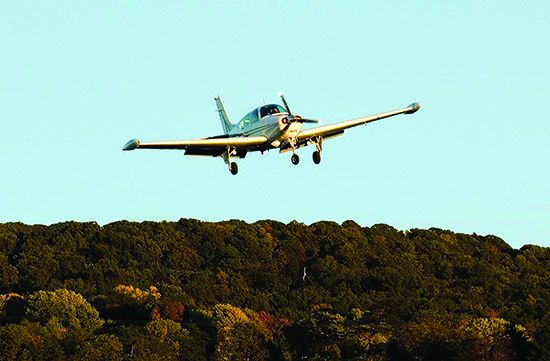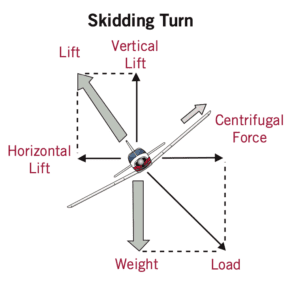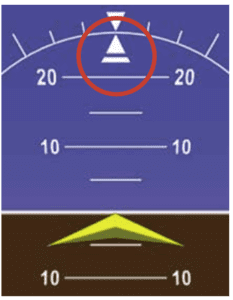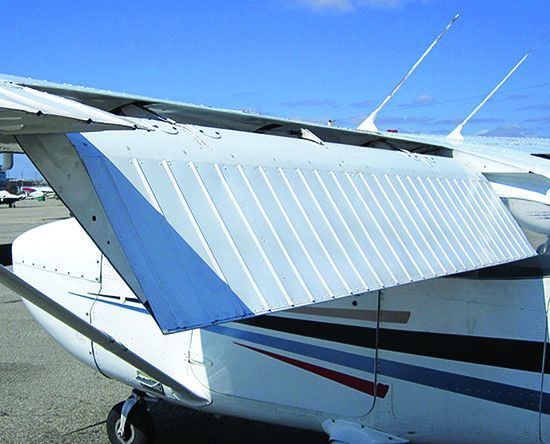
Has this ever happened to you? You’re in the traffic pattern and trending high on final. The throttle is at idle and the airplane is fully configured to land. Initially there may be a temptation to push the nose down, but the extra airspeed will probably lead to significant float. Staying on the current approach path will lead to a landing farther down the runway than we would prefer. Going around is always an option, until it isn’t.
If you are already one step ahead of me, give yourself a gold star; yes, we’re talking about slips. The first time I attempted a forward slip, I had to fight the voice in my head that was upset the ball was not centered. When I was first practicing the steps of a crosswind landing, I knew that aileron needed to be into the wind and opposite rudder was required to align with the runway. It took a bit of ground instruction to make the connection that this was also a slip. Let’s hop into a quick refresher on slips and their much less useful friend, the skid.
Slips
According to the FAA’s Airplane Flying Handbook, “A slip occurs when the bank angle of an airplane is too steep for the existing rate of turn.” This can occur unintentionally, such as uncoordinated rudder/aileron application, or intentionally, such as a forward slip to a landing. We typically employ a sideslip when landing in a crosswind (or zero sideslip when operating a conventional twin on one engine). The big difference between the two slips is that an airplane’s longitudinal axis in a forward slip is not aligned with the direction of flight, but the two are aligned in a sideslip. The diagrams on the next page might help. In a normal turn, a slip will result in the longitudinal axis following a path inside the turn. The inclinometer’s ball will be positioned to the inside of the slip, or toward the lowered wing.

To visualize this, consider yourself on a normal final approach, with minimal wind. The aircraft, from nose to tail, is aligned with the runway. To enter a forward slip, add aileron into the wind (if there is any). To avoid the aircraft veering off in the direction the aileron was added, opposite rudder needs to be applied. Ideally, both control inputs will be simultaneous and smooth. The aircraft should be moving in a straight line over the ground, but the longitudinal axis of the airplane will be diagonal compared to the relative wind. In essence, the plane will be flying straight, sideways. Make sense? If it doesn’t, the graphics on the following page may help.
The end result of this maneuver is an increase in overall drag. Why? Because you’re flying sideways, with greater drag than when coordinated. If you have a pencil handy, try this: Point it at yourself, eye level with the “nose” of the airplane facing you. The “airplane’s” cross-section is the diameter of the pencil, presenting minimal drag. Now pivot the airplane/pencil 45 degrees or so. How much more of that airplane will be struck by the relative wind? We rarely need a 45-degree heading change when performing a slip, but you get the idea.
At what airspeed should we fly a forward slip to a landing? Your normal final approach speed is a good target. Depending on how much altitude you need to lose, there’s no reason you can’t exceed that, as long as you always stay within the airplane’s limitations regarding things like flap extension speeds. It’s not a good idea to trend low on airspeed during a forward slip to landing. By turning the airplane’s fuselage into the wind, along with any static ports, we may induce error in the pitot/static system. Also, we’re close to the ground and would have less time and altitude to recover if a gust or control input resulted in a stalled wing.
Skids

Unlike slips, skids have zero useful function and should not be intentionally entered. During a skid, the ball on the inclinometer will be on the outside of the turn, or toward the higher wing. The pilot will feel a sideways force to the outside of the turn. In other words, the bank angle is too shallow for the rate of the turn.
If I am being honest, when I was attempting to learn about slips and skids, the above text just about made my head spin (no pun intended). If the diagram on the opposite page does nothing to alleviate confusion, there are a few helpful resources from NAFI and other organizations with some excellent videos demonstrating skids.
In the end, avoiding unintentional slips or skids is proper rudder and aileron management. Back then, my initial instinct was to focus on the rudder input because my brain has been wired to bank appropriately and coordinate with the rudder. Increasing or decreasing bank can also alleviate a slip or skid, but we have to be paying attention in the first place.
Skids Are A Greater Risk
Uncoordinated flight, while ugly, does not generally become hazardous until approaching critical angles of attack. In coordinated flight, even in a turn, a stall is just a stall, presuming we have air underneath us. In uncoordinated flight, a cross-controlled stall can very rapidly develop into a spin. This is another reason why skids are more hazardous than slips.
In a slipping turn, the high, outside wing will be at a higher angle of attack and stall first. If there is a competition for one wing to stall before the other, the high wing takes the cake. When the higher wing does stall, it will drop and the airplane will roll toward a mostly level state. At this point, the pilot should return the airplane to coordinated flight. Duh.
On the other side of the fence, skidding turns can result in a higher angle of attack on the low wing. If the aircraft is placed in a position near the critical angle of attack, and the low wing stalls first, two things happen that are far from ideal. When the low wing stalls, the loss of lift will further roll the aircraft into a steeper bank. While this occurs, the high wing continues to generate lift, and worse still, will generate lift in the direction of the existing roll. I am sure most of you are ahead of me when we arrive at the spin discussion. A skidding turn’s evolution into a spin is worthy of an article all by itself. In the meantime, check the diagram on the opposite page.

As is evident, I still often say things like “keep the ball centered” or “step on the ball.” The funny thing is I have way more time in aircraft that use what I call the “sky pointer,” a triangle functioning as a slip/skid indicator, circled here in red. The bottom half of the triangle functions similar to the ball, sliding left out of center if a slip or skid is developing. I have also seen digital versions depicting a traditional ball, which work the same way. Part of adjusting to glass cockpits should be maintaining the slip/skid indicator in your scan.
A lot of my recent flight time has been in aircraft with yaw dampers, which can make for a lazy pilot, at least when it comes to the footwork of flying. Most flights only need rudder input for takeoff and landing. I’ve had to direct some students to keep their feet on the floor because they ended up in a losing match with the damper.
Just as with any other automation tool, if your airplane has a yaw damper, click it off here and there. Keep those feet sharp.
Stall Recognition
As a quick aside, it was while I was working as a flight instructor full time that the PTS changed into the ACS and the discussion about “full” stalls versus “approach-to” stalls. It inspired many a spirited debate around the proverbial water cooler and, as a frequent fence-sitter regarding similar topics, I found myself in a familiar situation.
On one hand, I did agree that student pilots should feel an incipient stall and be comfortable with the aircraft all the way through the flight envelope, including the full stall and recovery. On the other, getting too cozy with high angles of attack can lead to complacency and loss of aircraft control at low altitudes, which is almost always fatal. Recovering the aircraft at the first sign of a stall is a safe technique and a good habit pattern to develop.
I bring this up as food for thought for the instructors and students out there, as well as a reminder to everyone that a pilot should be very aware of their angle of attack. Too often this is equated with speed, but as we will discuss in the following scenarios, speed is only one aspect of aircraft control to consider.
As we know academically, but often forget while operating, an aircraft can stall at any airspeed. At a minimum, we should all be familiar with how an aircraft handles at high angles of attack and be able to recognize the signs of a stall even before an annunciator or horn sounds off.

Some airplanes have limitations or recommendations regarding intentional forward slips. The most common example of this is the Cessna 172, where a placard may remind the pilot that slips will full flaps are not recommended. As we wrote in a 2004 issue:
“The book for an older Cessna 172 does say that steep slips with more than 20 degrees of flaps may show a slight tendency for the elevator to oscillate under certain combinations of airspeed, slip angle and center of gravity loadings. That’s because the flaps can partially blank airflow to the elevator. However, the same caution is not found in other Cessna POHs.”
Earlier 172s will indeed exhibit some elevator oscillation when slipped with full (40 degrees) of flaps extended. It can be felt through the yoke; old-school pilots might tell you that the oscillation helps inform them that they’re doing the slip correctly, and that it’s benign and easily disappears when recovering the slip back to coordinated flight. Later model 172s with “only” 30 degrees of flaps typically don’t exhibit this behavior. Meanwhile, the 1978 Cessna 172N carries a placard simply stating, “Avoid slips with flaps extended.”
This effect may be benign, but POH/AFM statements should be heeded. With some airplanes, they aren’t recommendations but limitations. All of which means you need to know what the manufacturer says about slips with flaps extended. Never make the assumption that because a slip in a certain model of the Cessna 172 was fine, it will be just as benign in another 172, or another make/model. — J.B.
Some Scenarios
I have to be honest, I really struggle to learn from text alone. I like some pictures, a good video or best of all, an instructor explaining it to me several different ways until the lightbulb actually goes off. So my goal with this section is to drive the theoretical home with some examples of how these threats can manifest in flight and, more importantly, how they can be mitigated.
Base-to-Final: The base-to-final turn can be a riskier phase of flight than straight-and-level. The aircraft is slow and low to the ground, and the environment is busy and dynamic. It is easy to see how the following situation can occur.
Consider an aircraft on left downwind at a non-towered field with gusty crosswinds. The pilot checks the crosswind, and it will be at the recommended limits for the aircraft, coming from the left side during landing. Any number of distractions pop up while on base, and combine with the wind pushing the pilot beyond the extended centerline—a runway overshoot looks likely. When the bank angle is not sufficient to align the aircraft on final, rudder is added to swing the nose toward the runway. Sound familiar? Due to the increased bank, the critical angle of attack rapidly approaches. Combining the skid, the loss of control and the low altitude is a sad but common recipe for an accident.
Engine Failure: The classic scenario is the impossible turn—trying to turn back to the runway after the engine fails—but any engine failure involving a late turn and stretching the aircraft’s glide capabilities fits the bill. In the end, it is the same formula of entering a skid trying to eke a little more performance out of the aircraft in a turn. The human factors involved in maintaining aircraft control while trying to find a suitable landing spot during a catastrophic emergency are worth a discussion all on their own, but it is tough to fault someone for entering a skid in this scenario.
Mitigation: Keep the ball centered. Consistently keeping the aircraft coordinated (outside of intentional slips when landing) will at least help prevent a spin if a stall inadvertently occurs.
Watch the angle: Slips and skids do not tend to end up as threats unless a stall occurs. Keeping a comfortable buffer against the critical angle of attack and knowing the situations (such as the ones listed above) where airspeed can rapidly decay low to the ground.
Don’t push it: Every base-to-final stall/spin accident could have been a go-around. An impossible turn resulting in a loss of control accident may have fared better as controlled flight into a less-than-ideal landing surface, such as trees.
See the signs: Noticing how the winds are affecting the aircraft during the downwind is a great first step toward mitigating a base to final threat. You can widen and extend the downwind to stop a problem before it even starts.
Skids induce risk with zero upside and should never be intentionally performed. Slips are a useful tool when executed appropriately and can simplify energy management, especially in airplanes lacking wing flaps. Outside of a forward slip to a landing or a sideslip, keeping that ball (or triangle) centered up not only increases your precision but it also could save your life.
After a career as a Part 135 pilot, flight instructor and check airman, Ryan Motte recently got hired by a major airline and is now flying as a Part 121 first officer.



